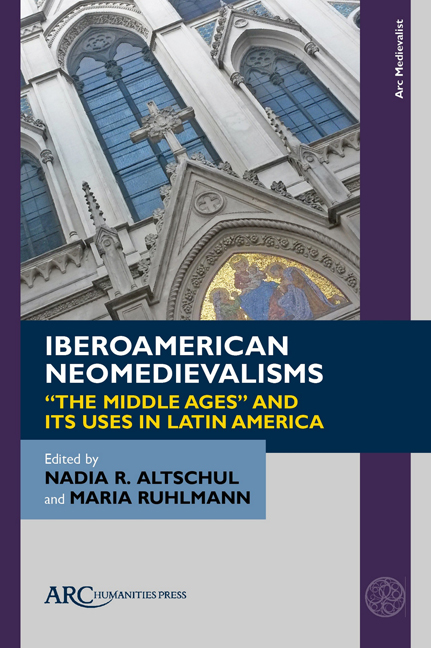Book contents
- Frontmatter
- Contents
- List of Illustrations
- Chapter 1 Postcolonizing Neomedievalism:An Introduction
- Chapter 2 The Criollo Invention of the Middle Ages
- Chapter 3 A Militant and Peasant-Based Medieval History in Brazil: Fanning the Spark of Hope
- Chapter 4 Neomedievalism and the Hagiography of Valdemiro Santiago: Neopentecostal Sanctification
- Chapter 5 The “Middle Ages” in the Brazilian Presidential Elections of 2018: The Left, the Right, and the Centre
- Chapter 6 Averroes in Mid-Colonial and Inter-Imperial Cordoba
- Chapter 7 Hypermedievalizing and De-Medievalizing Dante: Leopoldo Lugones’s and Jorge Luis Borges’s Rewritings of Inferno V
- Chapter 8 Borges and Kennings
- Chapter 9 Memory, Desire, and Sexual Identity in Manuel Mujica Lainez’s El unicornio
- Chapter 10 Rewriting and Visualizing the Cid: The Reconstruction of Medieval Gender and Race in Argentinian Graphic Novels
Chapter 8 - Borges and Kennings
Published online by Cambridge University Press: 18 November 2023
- Frontmatter
- Contents
- List of Illustrations
- Chapter 1 Postcolonizing Neomedievalism:An Introduction
- Chapter 2 The Criollo Invention of the Middle Ages
- Chapter 3 A Militant and Peasant-Based Medieval History in Brazil: Fanning the Spark of Hope
- Chapter 4 Neomedievalism and the Hagiography of Valdemiro Santiago: Neopentecostal Sanctification
- Chapter 5 The “Middle Ages” in the Brazilian Presidential Elections of 2018: The Left, the Right, and the Centre
- Chapter 6 Averroes in Mid-Colonial and Inter-Imperial Cordoba
- Chapter 7 Hypermedievalizing and De-Medievalizing Dante: Leopoldo Lugones’s and Jorge Luis Borges’s Rewritings of Inferno V
- Chapter 8 Borges and Kennings
- Chapter 9 Memory, Desire, and Sexual Identity in Manuel Mujica Lainez’s El unicornio
- Chapter 10 Rewriting and Visualizing the Cid: The Reconstruction of Medieval Gender and Race in Argentinian Graphic Novels
Summary
Kennings fascinated Jorge Luis Borges (1899–1986), both attracting and repelling him. Often described as a figurative circumlocution or a double metaphor in Germanic poetry (most commonly in Old Norse but also in Old English), the kenning is a highly stylized and artificial compound noun. Borges found kennings sufficiently intriguing in his early days as a creative thinker that he wrote and published a significant analysis of them. In that study, he placed them in the context of Old Norse and Old English poetry, but also brought to bear the Spanish poetic movements known as gongorismo or culteranismo (the rococo and aureate stylings of the Baroque period) and the modernism called ultraísmo, which had greatly appealed to the young Borges when he briefly lived in Madrid with his family. He reused the material from this piece repeatedly throughout his life, and developed it further in several projects. Borges cared deeply about kennings, and gave examples of them frequently in talks and conversations, demonstrating his knowledge and his liking for this stylistic quirk of early Germanic literatures. He put them in his poetry, as best he could. At the same time, Borges's attitude to the kenning was remarkably contradictory. He describes the usage in one interview as “rather a weariness of the flesh to the poets themselves–at least to the Old English poets.” Old Norse poets, he implies, seemed to enjoy them more and certainly used them more. However, he also cites their “poignant quality,” and states they are “the first deliberate verbal delight of a literature governed by instinct.” His choice of goce here, which I have translated as “delight,” may be an example of deliberate borgesian double meaning; goce can also be “choice, preference, taste.” Kennings might be a delight, but they might also simply be a preference of the poet. Borges might just as easily be suggesting here that kennings were the first step away from a literature of instinct and towards a literature of artifice, or stylistic excess, rather than that they were a new elegance in the literature. Since he places kennings in the context of Spanish literary periods of excess and great artifice, his implication might be that kennings are a sign of excess in an otherwise fascinating poetic oeuvre. Or not.
- Type
- Chapter
- Information
- Iberoamerican NeomedievalismsThe Middle Ages' and Its Uses in Latin America, pp. 139 - 154Publisher: Amsterdam University PressPrint publication year: 2023

